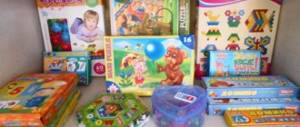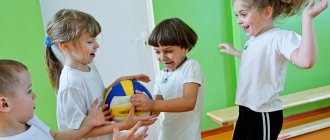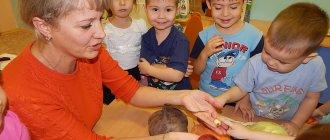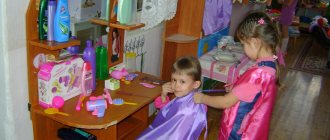Senior group. Senior preschool age. Children 5-6 years old
Photo report “Motor activity of children on a walk” in the senior group
Photo report “ Motor activity of children during a walk in the senior group” Jumping day at MAAM In our kindergarten, during a walk you can always hear children’s laughter, cheerful children’s voices are heard throughout the entire district. It is impossible to sit still: we are always running, jumping, galloping, playing ball,...
Outdoor play as a means of developing motor activity in children of senior preschool age. Relevance of this topic: is to raise a healthy generation with the harmonious development of physical qualities. In any society built on humanistic and democratic principles, human health is the highest value, the most important asset of the state, it is...
Organization of physical activity of children during a walk
Bibliographic description:
Kovaleva, I. V. Organization of motor activity of children during a walk / I. V. Kovaleva, N. A. Pushkova, T. A. Ushakova. — Text: direct // Pedagogical skills: materials of the IX International. scientific conf. (Moscow, November 2020). - Moscow: Buki-Vedi, 2020. - pp. 128-132. — URL: https://moluch.ru/conf/ped/archive/208/11236/ (access date: 10.10.2020).
Full and comprehensive development and education of preschool children is impossible without properly organized and sufficient physical activity, which has a huge impact on the health and physical development of the child. The growing body of a child needs movement, and satisfying this need is the most important condition for his life and development.
The motor activity of a preschooler is often determined by the motor regime proposed to him, which consists of organized and independent activity. When developing a rational motor regime in kindergarten, it is important not only to ensure that the child’s biological need for physical activity is met, but also to ensure that it corresponds to his motor experience, interests, desires and functional capabilities of the body. Therefore, the teacher must take care of its organization, diversity, as well as the fulfillment of the main tasks and requirements for its content.
Both in organized and independent games, it is necessary to promptly switch preschoolers from one type of activity to another, therefore it is very important that all children’s activities during a walk are directed and regulated by the teacher, and that each child is in his field of vision.
In the process of daily outdoor games and physical exercises during walks, children’s motor experience expands and their existing skills in basic movements are improved; agility, speed, endurance develop; independence, activity, and positive relationships with peers are formed.
A morning walk is the most favorable time for outdoor games and physical exercise. They are selected depending on previous work in the group, their number and duration vary throughout the week. So, on the days of organized physical activity in the hall during a walk, one outdoor game and some kind of physical exercise are organized.
When distributing games and physical exercises during the day, one should take into account the ratio of new program material offered during organized physical activity (both in the hall and on the street), with daily games and exercises conducted by the teacher during morning and evening walks. This helps to consolidate and improve movements.
The content of games and physical exercises during a walk should include:
1) the use of exercises of a predominantly dynamic nature, aimed at developing various muscle groups, as well as exercises that require high coordination of movements.
2) compliance of games and exercises with the season of the year and weather conditions;
3) the use of different ways to organize preschoolers;
4) rational use of equipment and inventory, environmental items;
5) creating favorable conditions for positive emotional and moral-volitional manifestations of children;
6) activation of children's independence;
7) stimulating the individual capabilities of each child.
A significant place is given to sports and competitive games, relay races. It is recommended to introduce movements that are well known to children, and to maintain interest, complicate the content, rules, and motor tasks (climbing over obstacles, crawling under an arc, running jumps, walking along paths, etc.).
In addition to outdoor games, during a walk it is necessary to widely use a variety of exercises in the basic types of movements.
Running at different speeds is proposed as an effective means of increasing motor activity and developing endurance.
When distributing exercises in the main types of movements, a significant place should be given to jumps and jumps. This is an effective means for increasing the motor activity of children and developing their speed-strength qualities and endurance. During the walk, you can create conditions in areas for using different types of jumps. Older preschoolers can be offered jumps on two legs in place (with a gradual increase in their number from 25 to 40) and with changing leg positions (legs crossed - legs apart, one leg forward - the other back; alternately on the right and left leg; with a turn and etc.); various jumping exercises: jumping from a height into a hoop, jumping onto low obstacles (on a bench, sled, snow hill), jumping over objects; long jump from a place and from a run, high jump from a run; jumping with a short rope in different ways.
Along with running and jumping exercises, throwing, throwing and catching exercises are widely used to prepare children for sports games (basketball, badminton, tennis). The content of a walk can include various movements with a ball (rubber and tennis): rolling on the ground, a narrow path; tossing and catching; dribbling; hitting the wall; rolling the ball into a hoop using a board; throwing at a target and at a distance.
In order to consolidate skills in basic types of movements, develop dexterity and maintain interest, children are offered a number of exercises in a certain sequence and with gradual complication on an obstacle course, where a variety of physical education aids are located - gymnastic benches, arches, throwing boards, racks with a rope. It is recommended to perform such exercises with children in the senior and preparatory groups. Performing exercises on an obstacle course should not cause any particular difficulties for children - after all, they are first mastered in classes.
During a walk, a significant place should be devoted to sports exercises that contribute to the formation of a variety of motor skills and qualities. Sports exercises are planned depending on the time of year (in winter - sledding, sliding on ice paths, skiing; in spring and summer - cycling and scootering).
The game exercises “Sled racing” arouse children’s interest,
"Be the first to succeed"
“On the sleigh!”, “Fast sledding”, etc.
While sliding along ice tracks (length 4–8 m, width 40–60 cm), older preschoolers are given different tasks: turn around, sit down and straighten up again, slide face forward after a run, placing your legs parallel or on one leg, catch a thrown snowball . You can invite children to run up and slide along short ice paths (2–3 m), located one after another at a distance of 3–5 steps.
Skiing is carried out twice a week, the first time during organized motor activity and the second time during organized outdoor games and exercises. The ski track is being laid on the territory of the kindergarten. It is advisable to have two circles: small (distance 100 m) and large (distance 200 m). In a small circle, children perform various motor tasks, and in a large circle they consolidate their skiing skills. Games and relay races are also organized here (“Step wider”, “Who is faster?”, “Counter relay”, etc.).
The construction of a ski hill requires special attention (slope no more than 15–20 degrees).
Older preschoolers enjoy riding bicycles and scooters. If at a young age they learned to use a tricycle, now they can easily master riding a two-wheeler. However, first the teacher must provide assistance, for example, support the bicycle with one hand on the handlebars, the other on the saddle, then only on the saddle, teach how to get on the bicycle, stop and get off it. This can be used if the equipment is available in the kindergarten, or if the children brought it from home.
In the future, it is necessary to give a variety of tasks with gradual complication: driving in a straight line, in a circle, one after another; with a turn to the right or left; driving in a straight line at different speeds, along a winding path.
When riding scooters, it is important to ensure that children alternate legs - pushing off with their right or left.
By the summer season, it is planned to equip a place for play in the kindergarten area in order to reinforce the rules of the street: mark intersections, install traffic lights, and child traffic controllers.
Along with sports exercises, children are offered games with elements of sports. In the senior group, they are introduced to the elements of the game of hockey; in the preparatory group, the number of exercises to consolidate acquired skills increases.
Older preschoolers are taught to play table tennis and badminton according to simplified rules. Children master various skills: holding a racket correctly, throwing and catching a small ball (shuttlecock), and navigating in space. To reinforce them, games with a tennis ball are offered: “Hold the ball”, “Ball down the hill”, “Roll it to the wall”, etc.
Exercises with elements of playing basketball are given with gradual complication: dribbling the ball with the right and left hands in place, around oneself, moving forward, changing the direction of movement, passing the ball to each other while moving along the court in pairs, dribbling the ball while running in pairs, etc. After mastering individual elements of the game of basketball, children learn games with the ball: “Take a free circle”, “Motorcyclists”, “Ball for the driver”, etc.
Training in sports exercises and games with sports elements is carried out through organized physical activity and reinforced by walking.
When selecting games and exercises for a walk, it is necessary to combine the main types of movements so that one is well known to the children, and the other is new, requiring a lot of attention and control from the teacher during its implementation.
An important point is the distribution of games and exercises, taking into account their intensity and complexity. It is advisable to alternate physical activity with rest, more active physical exercises with less active ones. Since some throwing exercises are considered ineffective in terms of intensity, the following combination is advisable to obtain appropriate physical activity: running - throwing (throwing and catching) - jumping. For example:
1) an outdoor game with running “We are funny guys”;
2) exercises with the ball: throw up and catch with both hands;
3) jumping on two legs with forward movement (distance - 6 m), jumping alternately on the right and left leg.
When selecting games and physical exercises, alternation of such types of basic movements should be provided that children could repeat with interest several times. Sometimes it is allowed to use the same movement both in an outdoor game and in a physical exercise. After skiing and sledding, preschoolers are reluctant to switch to playing with other types. This is explained by the fact that in a short time (10–12 minutes) children do not have time to satisfy their need for this movement. Therefore, it is advisable, after skiing on a training track, to offer games using skis: “Pick up an object”, “Who will turn around first?” and etc.
When selecting games and exercises, it is important to take into account the time of year, weather conditions and location.
During the warm period (September, May, June), games with longer running, racing, elements of competition, and relay games are required.
An approximate selection of games and exercises for a walk in the summer.
- An outdoor game with running “Fun Competitions”.
- Riding a bicycle in a straight line, in a circle, in a snake (at different speeds).
- Throwing sandbags into the distance (distance of at least 10 m).
In late autumn and early spring (November, March, April), the content of the walk should include a variety of physical exercises with a hoop, jump rope, ball games, ring games, etc. They can be organized under a canopy, on the veranda.
An approximate selection of games and exercises for a walk in the spring and autumn.
- An outdoor game with running “Catch up with your partner.”
- Rolling a hoop along a flat path (“Who will roll the hoop the furthest?”)
- Jumping rope in different ways.
In winter, it is planned to go skiing, sliding along ice paths using a variety of tasks (sit down, catch an object, turn around, etc.). The program content of a winter walk may include relay games on sleds and skis, games with hockey elements. The presence of various buildings contributes to the development of basic movements (walking and running through a snow labyrinth, along snow banks, throwing snowballs, going down a hill, etc.)
An approximate selection of games and exercises for a walk in winter.
- An outdoor game with running “Quickly take it, quickly put it down.”
- Sledging. Relay game “Sled racing”.
- Jumping from snow ramparts.
Planning work on the development of movements during a walk should ensure consistency, consistency in the delivery of program material, and increase the motor activity of children.
Considerable attention should be paid to the organization of games and physical exercises. The timing of them depends on the previous work in the group. If motor and musical activities took place in the first half of the day, then it is advisable to organize games and exercises in the middle or at the end of the walk, and at the very beginning, provide children with the opportunity to play independently and practice with a variety of aids. On other days, it is advisable to organize the motor activity of children at the beginning of the walk, which will enrich the content of their subsequent independent games.
When conducting games and exercises, you should use different ways to organize children. So, the teacher conducts an outdoor game with the whole group. The game is repeated three to six times (depending on the wishes of the children).
It is advisable to organize sports exercises and exercises in basic types of movements into subgroups. Each performs its own task, for example, the children of the first subgroup ride a bicycle, the children of the second practice different types of jumping rope. Such an organization requires the teacher to carefully select exercises, equipment, and monitor the children’s movements. When dividing into subgroups, it is important to take into account the characteristics of the motor activity of each child. As practice shows, it is advisable to unite children who are weak in any movement with those who are more prepared.
When organizing familiar games, the teacher can provide preschoolers with the opportunity to remember and tell the content of the rules themselves. The teacher pays attention only to important moments in the game, on which its course and compliance with the rules depend.
When learning a new outdoor game, it is necessary to give a clear, concise explanation of its content. Individual elements can be shown and even played. After the explanation, the teacher immediately moves on to the game and during the game clarifies what the children remember that was not good enough.
In outdoor games, preschoolers themselves play the leading roles. When organizing games of a competitive nature, relay races, an important role belongs to the teacher; he must help the children divide into teams of approximately equal strength. During the game, the teacher monitors the accurate implementation of all tasks and the relationships between the children. Of great importance is summing up, assessing the results, actions of children, their behavior in the game or when performing various exercises. It is advisable to involve children in discussing the results of the game, teaching them to evaluate their own behavior and the behavior of their comrades. This will contribute to a more conscious implementation of the rules of the game and the formation of positive relationships in the process of active motor activity of children.
Pedagogical guidance of children’s motor activity in independent activities during a walk
In addition to organized forms of work on the development of movements in the motor mode of children, independent activity occupies an important place. The child has the opportunity to play and move at his own request. However, even here his actions largely depend on the conditions created by adults. With proper guidance of children's physical activity, it is possible to significantly influence the variety of their games and movements without suppressing initiative.
One of the reasons for the low motor activity of children in independent play is the insufficient and irrational use of physical education aids and sports equipment (balls, hoops, jump ropes, bicycles, scooters, etc.). Taking into account the individual characteristics of children and relying on their interests, the teacher can show different options for more active actions with aids than those performed by the child, help enrich the game plot, fill it with a variety of movements.
Their communication has a significant influence on the motor activity of preschoolers in games. Introducing movements into games using aids increases the duration of children's communication.
Thus, in organizing the physical activity of children during a walk, two main stages can be distinguished. First, direct contacts between the teacher and each child are established, his interest in games, exercises and physical education aids, his relationships with peers are determined, and his motor experience is revealed. For the development of independent activity of children, the necessary conditions are created: timely assistance to each child in choosing games and exercises, physical education aids, and a place to play. At this stage, the following methods and techniques can be used: joint performance of the child’s exercises with the teacher or with other children; explanation and demonstration of more complex elements of movements; encouragement
The main direction of guiding children’s motor activity in the process of independent activity is to enrich it with a variety of movements.
At the second stage, a more intense influence of the teacher on the motor activity of preschoolers is carried out. Sedentary children are involved in activities that encourage them to develop an interest in play and exercise. Very active children are aimed at quiet activities, which will help reduce their motor activity and develop attention.
In the process of guiding children’s motor activity, significant place should be given to demonstrating a variety of movements with physical education aids. It is important to take into account the individual manifestations of each child. Thus, overly mobile children should be shown actions that require precision execution or special care when using the aid, for example, rolling a ball along a narrow board into a goal; hit a target with a bag of sand, etc. Sedentary children can be offered active actions and movements that do not require precision execution: throw a ball into the distance and run after it; jump from hoop to hoop, jump rope, etc.
A necessary technique in managing physical activity is to focus overly active children on low-intensity games and exercises (playing with sand, educational games, boom walking, climbing over a hoop, etc.), and inactive children on performing exercises using physical education aids ( climbing a gymnastic wall, running with a skipping rope, etc.).
When organizing physical activity during a walk, you should pay attention to:
‒ pedagogical techniques and methods of an individually differentiated approach, taking into account the child’s interests in games and various types of activities.
- take into account the previous and subsequent activities of children when organizing a walk.
- carefully consider the activities of children, taking into account individual characteristics, promptly switching from one type of activity to another, with a greater or lesser degree of mobility.
- think over a scheme for building up the site with snow buildings, taking into account the high physical activity of children in winter.
Key terms
(automatically generated)
: game, child, exercise, physical activity of children, outdoor play, main type of movement, walk, physical activity, kindergarten, significant place.





